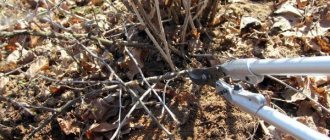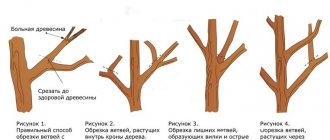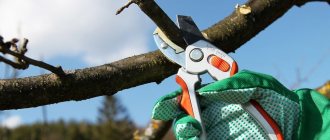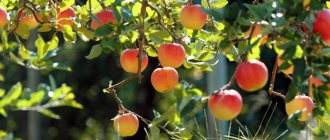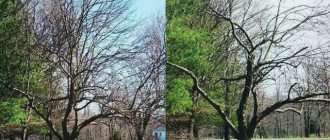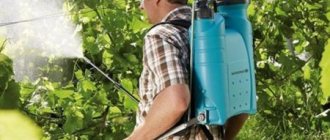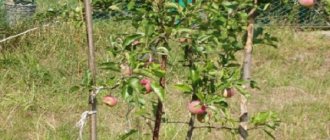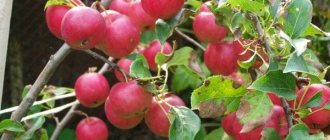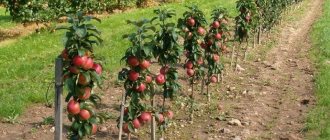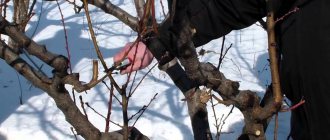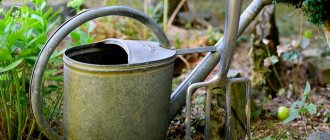Pruning dwarf apple trees should be done strictly according to the plan, since both insufficient and excessive manipulations negatively affect the condition of the garden. But when a gardener follows the rules of fertilizing and pruning, he gets a beautiful garden that produces good harvests. Never leave spoiled, decrepit branches on trees - the main source of various diseases and the main cause of rotting. Also, untimely pruning causes the death of young healthy branches. When the crown grows too intensively, the fruits grow small and unappetizing. Dwarf fruit trees take up very little space and produce high yields. They must be trimmed in order to create an optimal biobalance between the root system and the crown of the crop.
Dates
Autumn pruning is carried out in November after the leaves have completely fallen off. The procedure can also be done in the spring, but before the buds begin to swell.
When frosts begin, trimming is stopped. Do not ignore this moment - otherwise an open wound may form in the cut area, which will begin to freeze and rot.
Autumn
- Old branches that have deteriorated or broken need to be cut out.
- Next, in the place where a large number of small branches grow, the crown is thinned out, leaving the smoothest and strongest sprouts.
- All painful, crooked branches that extend at a slight angle from the trunk need to be cut off (they still cannot support the weight of the fruit during harvest seasons).
- Remove tangled, rubbing branches, remove stumps from the ring.
- Carefully iron the cut areas of the branches to remove any unevenness and burrs so that the matinees do not injure the phloem, then treat them with garden varnish.
- Wounds can be sealed with drying oil or oil paint.
This link will tell you how to cover a saw cut on an apple tree.
At the end of the work, all the branches that have been cut are collected in one place and burned to ashes.
Spring
In the spring, pruning of apple trees and currants of the Black Pearl, Sugar and other varieties is done before the buds swell. The cut areas need to be treated, as in the fall, with garden varnish. Shorten the shoots above the buds so that on one side of the edge the medium is at the level of the upper bud part, and on the other make a bevel to allow water to roll off.
External procedures protect the cut areas from frost; due to the active movement of sap in the spring, wounds heal faster.
In the spring, crown molding continues, removing all frozen shoots. Don’t forget about the crown - the lower and middle branches should be longer than the upper ones, and the top should be located above the crown. Only the tops of dwarfs are always removed. Read about the scheme for pruning columnar apple trees in the spring in this material.
Care after pruning apple trees
After pruning, the apple tree needs to provide a number of manipulations:
- Remove all trash.
- Cover strong cuts with garden varnish.
- Spray against diseases and pests.
- Feed with nitrogen in the spring and organic matter in the fall.
- Water the plant.
After all these procedures, the apple tree will noticeably begin to grow and will look more tidy.
Fertilizing the apple tree.
Trimming Features
Any pruning of a dwarf tree begins with thinning out the leaves - if there are too many of them, the plant will not receive adequate nutrition. If the crown volume is reduced, great harm can be caused to the crop.
Kidney removal
In spring, the upper buds awaken first and produce the first shoots. Always look at the competitive shoots located in the area of the upper bud and overtaking the ovary at the top of the apple tree. It turns out that fast-growing shoots are many times faster than the growth of the main shoots, so the correct shoots may not grow. To prevent this, get rid of the upper buds in a timely manner. After removing them, the middle ones will begin to actively develop, and you will get viable, strong shoots.
Before pruning, carefully inspect all buds and leave those that will have the right effect on the growth of the dwarf tree.
Crown formation
The formation of the crown is carried out twice a year - in autumn and spring. During these periods, young shoots do not have time to enter into active growth. Take into account the growth characteristics of seedlings and the variety of a particular crop - these parameters affect the rules for pruning buds. If the crown needs to be enlarged, young shoots are directed outward (this way the apple tree will look more compact, and its branches will not begin to stick out and droop unsightly).
When pruning the crown, remember that branches cannot grow the same; there will always be weak and strong shoots among them.
Strong branches overtake the main ones and interfere with their normal development, which can lead to the death of weak thin branches. To prevent this from happening, regulate the growth of branches, leaving strong branches under weak ones, and not vice versa. The crown is formed at the initial stage of apple tree growth. When the fruits begin to actively grow, pruning becomes more intense, since the branches become overloaded under the weight of the apples, which negatively affects fruiting and the quality of the harvest.
Pruning on rootstock
Pruning is carried out after the crown has formed. Wait a few years until the plant gets stronger and begins to actively develop. Within 2 years, the main shoot, which is often called the “leader,” should be fully formed. The crown will have time to acquire quite a lot of unnecessary branches. In spring, remove young branches so that the main ones have enough nutrients. If this requirement is ignored, yields may decline. As a last resort, try the procedure in the summer. This article will tell you about apple tree rootstock.
Pinching shoots
Pinching shoots is an important requirement for caring for dwarf trees. Pruning involves removing young, but not yet lignified, shoots. All manipulations are carried out manually by pinching off non-viable areas of the shoot. If you need to remove the main part of the plant, use pruning shears, which cope well even with thick branches. Pinching is done when the buds emerge next to the leading branch. Read how to pin an apple tree here.
Pinching is done in stages - a total of three times, the interval between procedures should be several weeks. Have time to perform pinching before the growth of the shoot stops - when it is formed, a full-fledged bud will appear, it will already be a full-fledged branch, and not a sprout.
Thinning apple trees
The slower the apple tree grows, the more fruit it will bear. This is good for the crop and bad for the plant itself, since it puts enormous stress on it. To prevent the tree from becoming depleted, apple trees are thinned out. This is done in June, when the excess ovaries begin to fall off spontaneously (it is enough to carefully shake the branches).
Pyramid pruning
Pyramid pruning in Russia is considered the most popular. It allows the formation of a central conductor up to 2 m in height with an average branch length of up to 1 m. The crown of the pruned tree should taper from bottom to top, forming a geometric figure.
Pruning semi-dwarf apple trees Russian spindle
For dwarf apple trees there are several types of crowns: “slender spindle”, “flat spindle”, “dwarf pyramid”, “new Russian spindle”. The last one on this list is the most popular.
Crown formation scheme - flat spindle
Crown formation diagram - dwarf pyramid Crown formation diagram - slender spindle
This formation was developed at the end of the 20th century for Russian conditions. The small leader shape of the crown in the form of a spindle allows for high yields. Grafting by budding on medium-sized rootstocks is carried out at a height of 10-15 cm, and on dwarf rootstocks - 5-10 cm. The establishment of skeletal branches occurs at a height of 0.6-1 m. The method of forming a “new spindle” is divided into three stages: pruning the central conductor, skeleton-forming branches and work with fruit-bearing branches. There must be one central conductor, located strictly vertically, without branches. To form a crown, you need to use all the side branches, moving them to a horizontal position using small weights and spacers. Any side branch should be half as thin as the central conductor. If it overgrows, it is removed, leaving an oblique cut.
The lower semi-skeletal branches should have 3-5 weak lateral branches, the branches in the middle of the trunk should have 1-2, the upper ones are the weakest. Once the lower branches have reached their maximum length, they must be shortened to a suitable side branch. The same applies to branches that are too drooping. Next, over the course of several years, it is necessary to repeat all the cycles of pruning and care on new tiers. They must be laid annually until the tree grows to a height of 3-3.5 m. At the same time, it is necessary to promptly cut excessively thick branches (more than half the diameter of the main trunk) into an oblique cut or transfer them to a thin side branch.
Pruning by age
Pruning rules also depend on the age of the tree. Let's take a closer look at this point.
1st year of life
While the one-year-old seedling is dormant, it must be pruned. The maximum permissible plant height is 50 cm. I make a cut on the bud opposite the graft. As a result of competent first pruning during the summer, 5 fairly strong shoots should form on the tree, the top one will be located vertically.
During the summer, the dwarf apple tree is not touched.
2nd year
With the arrival of spring (late March-early April), you need to cut off the central conductors, leaving about 20 cm. You can also remove the side branches, the growth of which is directed downwards. In the future, it will be possible to shorten the side branches by 3-4 leaves, leaving the conductors.
3rd year (three-year)
In the 3rd year of life and beyond, pruning is carried out in the same order as in the 2nd year. Work on a three-year-old apple should begin in early spring, removing side shoots up to 20 cm and cutting off the central branch. In summer, side shoots are shortened by 3 leaves, second-order shoots are reduced by 1 leaf. The conductors are left as is.
Adult dwarfs
Pruning of an adult apple tree is done annually, removing growth at the end of spring. The side branches are removed after they reach 50 cm. The pyramidal shape is maintained by removing powerful vertically directed growths. The main goal of caring for adult dwarfs is to remove excess branches and shoots, maintain the yield at maximum levels and properly form the crown.
Read about the dwarf apple tree Wonderful here.
The growth of a dwarf apple tree as a result of annual pruning should not exceed 2-2.5 m.
Pruning apple trees at 3 years old
When young trees reach three years of age, there is no need to prune young trees too much. In addition, it is necessary to add new skeleton-forming branches. If the central trunk grows too quickly, it must be restrained by pinching or lightly trimming the crown.
Trimming the central conductor and side branches by 20 cm
If you need to rejuvenate a dwarf apple tree
European gardeners have developed their own system for pruning old ones, which helps restore even very neglected plants - this is a renewal system. The technique is complex only at first glance. The main thing is to take into account the main characteristics of the crop and focus on reducing the share of annual growth. The stepsons should be shortened by about one third, cut off the smaller half. On the weakest tree, only the top can be cut off. Space the fruits and twigs well along the length of the branch - this way the fruits will definitely not be crowded. Reduce the number of stepchildren to the maximum, not forgetting that their total number should correspond to the variety and growth rate of the apple tree. Ideally, a fruit tree is left with only one leading (central) branch - two leaders weaken the plant.
In early September, rejuvenation is usually not carried out.
Is it possible to prune an apple tree in the fall?
There is debate among professional gardeners about when to prune an apple tree, in the fall or in the spring. Proponents of spring pruning cite the following arguments:
- If you remove unnecessary branches before the sap begins to flow, the wounds on the trunk will heal faster.
- In the spring, the tree’s natural defense mechanisms begin to turn on and actively fight pathogenic microflora that has entered the cut.
- In March and April, you no longer have to be afraid of frosts, which have a detrimental effect on plantings weakened by pruning.
Autumn pruning of apple trees has its advantages:
- After harvesting, the gardener has more time to devote to removing unwanted branches.
- After pruning over the winter, the fruit tree's root system will increase.
- In autumn, the growing season stops, so you can remove branches without the risk of damaging the buds or growing shoots.
When can you prune apple trees in the fall?
Having decided on the need to remove unwanted branches after harvesting, it is important to correctly determine the timing:
- Autumn pruning of an apple tree for the winter is carried out after the leaves begin to fall. If the weather permits, it is better to wait until all the leaves are on the ground, so the crown will be visible much better.
- Pruning is carried out on a clear sunny day. If precipitation is forecast, it is better to postpone the procedure. Wet cuts heal worse, and pathogenic bacteria can begin to multiply in them.
- Another important factor is frost. After removing the shoots, it should take at least 2-3 weeks for the tree to gain strength, so plan pruning your apple tree in advance.
Newbie mistakes when trying to prune a semi-dwarf or dwarf apple tree
Recommendations for proper tree pruning for beginners:
- It is not advisable to save on tools, since poor pruners and scissors do not cope with the assigned tasks. Don't forget to take care of it.
- Too much pruning is just as harmful as no pruning at all.
- If there are few fruit-bearing branches on the branches of the apple tree, or the lower branches are still bearing fruit normally, you need to find and expose a healthy bud, and then cut through the bark a little higher.
- Prune apple trees only when they are dormant - late winter or very early spring.
- Act decisively, remove large branches that do not bear fruit.
- Be careful not to remove all the branches at once - otherwise the tree will receive a traumatic shock, which can even lead to death.
Excessive pruning activates the growing season and reduces yields.
Pinching shoots
Pinching (pinching) is considered one of the important elements of pruning in the summer. It consists in removing non-lignified young shoots. It is better to carry out this procedure in the summer. Usually this manipulation is carried out by hand, pinching off part of the shoot (hence the second name), but sometimes they use pruners if it is necessary to remove a large, main part of the shoot. Young shoots are pinched only when buds emerge close to the leader branch, or when an unwanted shoot appears, which will contribute to the incorrect formation of the crown of your pet. Pinching the newly formed shoots in the summer will allow you to avoid cutting into a ring with the onset of the next winter period. And only when the sprout becomes woody in the lower part, you can get rid of it with the help of pruners.
By tweezing in the summer, you will help the tree retain nutrients and direct them to foliage growth, enlargement and development of axillary buds. Each pinching is carried out in several stages. The best option would be 2-3 times over 7-10 days. After all, the growth of shoots is significantly different: the closer to the trunk (trunk), the weaker it is and vice versa.
If you started the first pinching with the onset of June, then the next one should be done in early July. If a third pinching is needed, it will have to be done in August, but this comes with its own risks. Young shoots may not have time to mature and the winter cold will destroy them.
If pinching is carried out correctly, the vigorous and active growth of developing young branches can be reduced. As a result, small and weak shoots will be strengthened. Timely pinching significantly affects the growth and development of the tree. Remember, pinching is carried out until the shoot stops growing. If the shoot has formed into a full-fledged apical bud, there is already a branch in front of you and it is not allowed to use tweezers on it.
Read also: Anna Shpet”, plum: description of the variety, cultivation features and reviews
